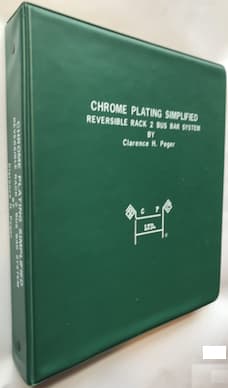
Curated with aloha by
Ted Mooney, P.E. RET

The authoritative public forum
for Metal Finishing 1989-2025

-----
CHROME BATH PROBLEMS
Q. MY NAME IS KEVIN PROCTOR AND I WORK AT A PLATING SHOP DOING "HARD" CHROME.
I'M NOT A CHEMIST NOR DO I PRETEND TO BE ONE SO I NEED SOME LAYMAN'S TERMS HELP WITH MY QUESTION. OUR CHROME BATHS SEEM TO LOSING CONDUCTIVITY, ex., WHAT WE USED TO BE ABLE TO PLATE @ 1200 AMPS NOW TAKES 2000 AMPS..OR IF WE RAN X AMOUNT OF PARTS, WE NOW HAVE TO RUN LESS PARTS @ MORE AMPS TO GET ENOUGH CHROME THICKNESS IN THE SAME TIME. MY GUESS IS SOME KIND OF CONTAMINATION BUT ANY SUGGESTIONS OR IDEAS WOULD BE GRATEFUL. AGAIN I AM JUST A WORKER AT THIS SHOP AND REALLY DON'T GET INTO ALL OF THE CHEMISTRY TERMS.
THANKS.
SHOP EMPLOYEE - ELMIRA, New York
2007
|
|
"Chrome Plating Simplified"
by Clarence H. Peger (You're unlikely to find this for sale ... but copies are in select libraries)  from AbeBooks * rarely available * or eBay * rarely available * or Amazon * rarely available * (affil links) A. Trying to find the answer yourself through a chat forum would be the last resource in my opinion. Don't you have a supervisor, a more experienced peer or someone in your company that you can ask? Has someone checked the chromic oxide and catalyst levels? Why do you suspect about contamination? Have you been processing strange materials, left the tank exposed to unauthorized personnel? Guillermo MarrufoMonterrey, NL, Mexico 2007 A. You are on the right track. Look into porous pot technology for solution purification. Initial cost is a bit high, but operational cost is quite low as well as the man hours to keep it up. I do not know if they are still in business, but try calling Hard Chrome Consultants in Cleveland, OH. They had the cheapest fully operational unit that I ever found. A TINY company. James Watts- Navarre, Florida 2007 |
|
|
A. There are numerous reasons why this type of problem can be occurring. First get a chemical analysis to see if the chromic acid and sulphate are at the correct levels/ratio. Then check the bath temperature. Now look at the anodes. They should be a chocolate brown color. If not, note the color. The color is an indicator of various types of problems. (You should also get a copy of
Metal Finishing Guidebook for some troubleshooting info) Next check the electrical connections to make sure that the power shown on the rectifier is actually getting to the work. process supplier - Great Neck, New York 2007 A. From my beginning days in Physics I recall V=IR or voltage equals amps times resistance. If you need more and more voltage to carry the same current (i.e. amps), your resistance is increasing. With hard chrome, this can come from any number of places: filmed over anodes, increased trivalent chrome or metallic contamination (do you reverse the parts in the chrome tank), corroded or heating up of cable connections, etc. I'd suspect the anodes first; also, I agree with the "porous pot" prescription from Peger's place in Cleveland - they're dirty to use and clean but keep your chrome electrolyte operating the same way month after month, year after year.  Milt Stevenson, Jr. Syracuse, New York 2007 |
by Robert K. Guffie

on AbeBooks
(rarely)
or eBay
(rarely)
or Amazon
(affil links)
A. I would look if there isn't any part on the bottom of your tank. Sounds something fell in and is dissolving, Fe concentration is rising and conductivity will rapidly drop. The higher the valency of the metal ion the larger the effect on the conductivity. (Fe3+, Cr3+, Al3+ etc.)
The porous pot is certainly a way of removing these cationic impurities but it has a very poor efficiency. ( <6% for removing cations like Fe). The best prevention is in good housekeeping and external etching (if you can).
- Netherlands
2007
Q, A, or Comment on THIS thread -or- Start a NEW Thread
